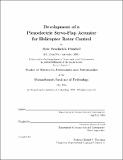Development of a Piezoelectric Servo-Flap Actuator for Helicopter Rotor Control
Author(s)
Prechtl, Eric Frederick
Downloadprechtl_smthesis.pdf (934.5Kb)
Metadata
Show full item recordAbstract
An actuator using a piezoelectric bender to de
ect a trailing edge servo-
ap for use
on a helicopter rotor blade was designed, built, and tested. This actuator is an
improvement over one developed previously at MIT. The design utilizes a new
exure
mechanism to connect the piezoelectric bender to the control surface. The e ciency
of the bender was improved by tapering its thickness properties with length. Also,
implementation of a nonlinear circuit allowing the application of a greater range of
actuator voltages increased the resultant strain levels.
Experiments were carried out on the bench top to determine the frequency response
of the actuator, as well as hinge moment and displacement capabilities. Flap
de
ections of 11.5 deg were demonstrated while operating under no load conditions
at 10 Hz. Excessive creep at low frequencies precluded the measurement of achievable
hinge moments, but extrapolation from de
ection and voltage characteristics indicate
that if properly scaled, the present actuator will produce
ap de
ections greater than
5 deg at the 90% span location on an operational helicopter. In addition, the rst
mode of the actuator was at seven times the rotational frequency (7/rev) of the target
model scale rotor. Proper inertial scaling of this actuator could raise this modal
frequency to 10/rev on an operational helicopter, which is adequate for most rotor
control purposes.
A linear state space model of the actuator was derived. Comparisons of this
model with the experimental data highlighted a number of mild nonlinearities in
the actuator's response. However, the agreement seen between the experiment and
analysis indicate that the model is a valid tool for predicting actuator response.
Date issued
1994-04-24Publisher
International Center for Air Transportation
Series/Report no.
ASL-94-2
Keywords
piezoelectric, helicopter, Air Transportation